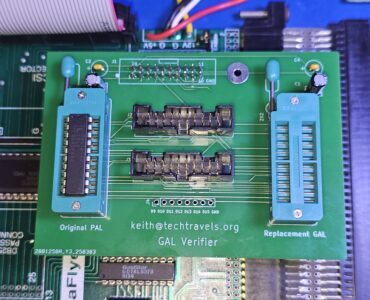I hate leaving projects for awhile. Any more than a few days, and you lose the focus, you lose the insight, and remembering exactly where you left off can be a pain in the butt. This time, I’ve come back to a...
progress on windows side
I put some time into the windows program that makes this whole thing tick tonight. When I first started this project, I started with Marco’s afr.c, and pared it down to the bare necessities. Then, I modified...
added version control and another command
I’ve really wanted version control for a long time. The ability to go back and undo diverse changes across sessions is valuable. I also feel a little safer and don’t mind doing semi-destructive edits...
vacation reading
While I’m on vacation this week, I’m reading a book about making your own circuit boards using Cadsoft’s Eagle. Eagle is a schematic capture and board layout program that seems pretty popular and...
semester is over
Welp, my spring semester is over, so I’ll have more time to dedicate to the project. A couple quotes I like on Perseverance: It’s not that I’m so smart, it’s just that I stay with problems longer...
added commands
So I’ve added commands to support forward/backward stepping and upper and lower sides. R for Read D for Dump F/B for stepping either Forward or Backward U/L for selecting upper or lower side. I’ve tested...
March 21st Status
Well, here’s where I’m at: The external amiga floppy drive is now hooked directly to my SX microcontroller. The code within the microcontroller waits for a command. If it get’s a “B”...
Good news. Floppy now under SX control
OK, so I finally bit the bullet and have the floppy drive under direct SX control. I have my amiga power supply, which is a modified PC supply with harddrive leads powering the drive directly with +12v and +5v. I also...
out of the country!
I just left Amsterdam, and now am spending some time in Brussels.
I have some preliminary photos up in the gallery.
Floppy project is still on my mind!
Elusive step pulse caught!
So I finally caught a pulse, on the same pin. They were just happening quickly and irregularly and so catching on the scope was tough.
working on the floppy interface
Well I’m now inline with a data tap, so I have access to all 25 pins on the floppy interface between the amiga and the floppy drive. I used to attach to the DB23 on the pass-thru port of the floppy drive, but I...
Commands A and B implemented and working
Ok. I got two commands A and B implemented and working. Command B from the PC instructs the SX to enable interrupts, and get ready to receive a track into fram. This command will eventually be expanded to actually...
USB uart send and receive
Good news, good news. After banging my head on the same problem for the last three hours, I’ve finally made some more progress. Using option #2 from the previous post, I’ve written two non-isr based software...
writing merged USB comm code
Now that I have USB receive working in the main PC code, its time to merge the USB transmit(and receive for commands) into the main SX code. I have two pseudo-code versions written. 1> First version uses the ISR to...
merging USB receive
Well, I’ve managed to merge the USB receive portion into the main program that reads and processes tracks. This means I no longer need an external program to receive the data, to write it to a file, to read the...
new book
I recently received “On the Edge: the Spectacular Rise and Fall of Commodore” and have read about half of the book so far. Very interesting read. It’s fun to read about how the various Commodores...
proof of concept works
Today is the first day in months that I’ve made what I consider good progress. I am now able to read any track(so far) off of any disk with 100% success including checking and relying on the checksums. I read...







